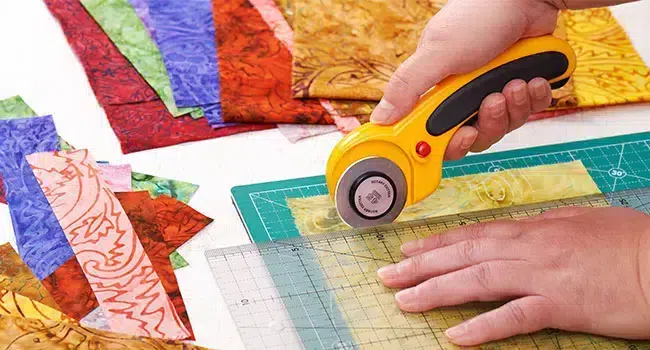How Can I Increase the Lifespan of My Cutting Mat?

Whether you are a crafter, a self-employed textiles specialist or an established organisation with numerous employees, getting the most out of your cutting mat is always important. High-quality cutting mats are a real investment and as with all investments, maintenance is key to taking full advantage of your purchase.
Rhino Cutting Mats is one of the most recognisable and respected brands in the industry, having produced self-healing cutting mats here in the UK for over fifteen years. During this time, we have handled and maintained countless different cutting surfaces, working with creators and businesses in a range of industries to help them get the most out of their workspace.
In this guide, our team will work through some of the major points to consider when you are looking to maintain your cutting mat effectively. By following these tips, you will be able to increase the lifespan of your mat, ensuring that you are benefitting from the best cutting surface on the market for as long as possible.
If you are also setting up or upgrading your workspace, pairing your mat with the right workbench can make a major difference to productivity and comfort. Our guide on choosing the right heavy duty workbench explores how to find a surface that supports precision cutting and durability in demanding environments.
Use the Right Type of Knife
There are multiple different kinds of cutting mats, each suitable for various types of knives. Ensuring that you use the correct knife for your cutting mat is essential for improving its lifespan. If we were to categorise the common knives used during textiles, printing or crafting work, they would be split into two sections – straight blades and rotary blades.
Straight blades are the most common and the majority of cutting knives on the market fit into this category, including Stanley knives, the traditional hobby knife option. If you are running a small crafting business, you’re likely to be using straight knives and will need to find a cutting mat that works well with these blades.
On the flipside, rotary blades are circular. This makes regular cutting easier and requires less pressure to be placed on the top of the knife. Instead, the blade is pushed forwards with a small amount of downward force to create a single, smooth cutting motion. Crafters and businesses that require a higher level of productivity are likely to use these blades and due to the differing levels of pressure put on the blade, the cutting boards suitable for rotary blades differ.
Rhino cutting mats are suitable for use with both types of blade, though some are more suited to industrial applications than others. Regardless, you might find that your cutting mat is designed for a specific type of blade, in which case, make sure to exclusively use that type of knife, otherwise, you will cause greater damage to the mat’s surface.
Sharpness is Key
Damaging the surface of your cutting mat is inevitable. By design, the mat is meant to be cut into, so you cannot avoid its eventual wear and tear. However, there are ways to reduce the damage. By ensuring that the blades you use are sharp, the cuts into the mat become finer and less noticeable, resulting in a longer-lasting product.
This is particularly important when you are dealing with self-healing cutting mats, as smaller cuts from sharper blades are easier for the product to heal. Furthermore, if you are using a blunt blade then you will need to increase the cutting pressure you are exerting. Not only does this result in further damage to the cutting mat’s surface, but it also increases the risk of the blade slipping.
Keep your blades sharp and replace them regularly to ensure the safest overall experience and to increase the lifespan of your cutting mat.
Store Correctly
The majority of cutting mats are made using a range of different polymers. Many polymers are heavily affected by heat, which is why cutting mats should be stored in a cool, dry location away from intense heat. The same applies when the mat is being used – avoid exposing the cutting mat to prolonged or intense periods of heat and you will be able to keep it in top condition for much longer.
Clean Your Cutting Mat Regularly
When you cut into your mat, you are creating countless tiny spaces within the mat’s surface. Unless you are using a self-healing cutting mat, these spaces never go away and if anything gets inside them, it can cause damage to the mat’s overall health. Anything from grains of sand to tiny stones can lead to very slow levels of erosion within the mat, widening these tiny cuts and making them more noticeable.
To avoid this, ensure that you clean your mat regularly. Use warm water and mild detergent with a small brush if you can see dirt within the mat, otherwise, a gentle wash should be enough.
By following these steps, you should be able to significantly extend the lifespan of your cutting mat.
Customers who regularly use cutting mats for industrial or creative work may also benefit from learning how to protect their work surfaces. Take a look at our article on what’s the best workbench protection to discover effective ways to prevent wear and maintain your workbench alongside your cutting equipment.
Rhino Cutting Mats are the original Rhino brand, producing and supplying a range of different mats for a variety of requirements and industries. Whether you need our industrial grade Heavy Duty Cutting Mat or would prefer a lighter, simpler option like our Green Self-Healing Cutting Mat, we have a solution for you.
If you have any questions, please don’t hesitate to get in touch and our team will gladly advise you on the best cutting mat for your personal requirements.
